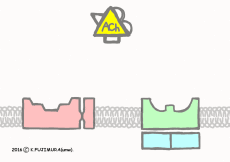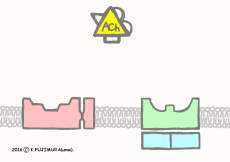[053] Acetylcholine receptors (GB#114B03) | 基礎医学教育研究会(KIKKEN)Lab

Neurotransmitters and receptors are taught as keys and keyhole-like relationships. So, somehow, we assume each other is the only one. But, there is something called a master key in the key, so we can not be careful. For example, acetylcholine can react with two types of receptors whose keyhole is totally different.
—
Contents
- 1 ● Acetylcholine binds to cell membrane receptors
- 2 ●Receptors are distinguished by agonist’s effectiveness
- 3 ● Acetylcholine is a three-dimensional object
- 4 ● Quite different mechanism of N receptor and M receptor
- 5 ● Several small types of receptors
- 6 ● The response of cells by N receptors is fast
- 7 ● Slow cell response by M receptor
- 8 ● Receptor at the right place
- 9 ● Antagonizing substances are also different
- 10 ● Neither agonist nor antagonist is easily degraded
- 11 ● No functional meaning to the structure of transmitter
- 12 ○ Referenced sites
- 13 ○ Related articles
- 14 ○ Referenced books
● Acetylcholine binds to cell membrane receptors
Acetylcholine is one of the neurotransmitters that cause cells to respond by binding to receptors heading out to the cell membrane from outside the cell at the synapse. As for the receptor, the substance of the partner to which it binds is fixed, and the acetylcholine receptor is only acetylcholine that can bind as a substance in the body. For a given receptor, a specific substance in the body to which it binds, such as acetylcholine, is called the ligand of that receptor.
●Receptors are distinguished by agonist’s effectiveness
From the side of acetylcholine, receptors are divided into at least two groups having different structures and mechanisms. One is known as a nicotinic receptor because it is known that cigarette nicotine is a partner in addition to acetylcholine. Also, if you know that it is acetylcholine receptor, it is also abbreviated as N receptor. The other is known as a muscarinic receptor, also abbreviated M receptor, as it was found that a substance called muscarine of poisonous mushroom binds.
Nicotine and muscarin are not inherently in the body. Originally not in the body, a substance that binds to the same receptor as the ligand and causes the same action is called an agonist. Many agonists are used for medicine if they are in a trace amount, but disturb the original physiological signal transduction, so it becomes poisonous if you misunderstand the amount. Even with nicotinic receptors, there is no meaning as “a receptor prepared for nicotine”, but it is only used as a “name tag” for human beings to distinguish receptors.
● Acetylcholine is a three-dimensional object


The structure of the molecules of nicotine and muscarin are quite different. Nicotine does not act on muscarinic receptors, and muscarin does not act on nicotinic receptors. Therefore, the form of the part to which the agonist binds (binding site, binding site) should be completely different from each other. However, acetylcholine can bind both receptors. Beginners here will be hazy. What does “acetylcholine” mean that two distinct binding sites are recognized as their opponent? That’s why.
Elementary school student Tom is a child of Jack and at the same time is a child of Michael, so it seems that there are some complex circumstances, but it is a feeling that it is better not to deeply enter into the poor. Probably Moyamoya seems to be in the background that the explanation in ordinary lessons is tidied only by name. The actual trick is easy, Jack is a woman and a mother. It is not a story, but only acetylcholine has a different way of binding to each receptor.
Since acetylcholine is a three-dimensional object with irregularities, it is no wonder that if the angle of view changes, it will look different in shape. Nonetheless, it seems not as simple as this animation, but in order to understand roughly, you only need to notice this trick.
![]()

![]()
● Quite different mechanism of N receptor and M receptor
Although the N (nicotinic) receptor and the M (muscarinic) receptor are next to each other in the alphabet, the subsequent mechanisms are completely different. N receptor is representative of ionotropic receptors. M receptors, on the other hand, are representatives of metabotropic receptors.
Ion channel type acetylcholine receptor (N receptor), from a different perspective, ligand It is also a representative of a gated ion channel. The receptor molecule penetrating the cell membrane itself incorporates an ion channel, the ligand binding changes the shape of the molecule, and the channel opens or closes to give a signal to the cell.
Metabotropic acetylcholine receptor (muscarinic receptor, M receptor) penetrates cell membranes like ion channel type, but does not have ion channels. How to convey a signal is that when the shape of the receptor molecule changes, it creates specific substances inside the cell membrane and spreads it. This substance becomes a signal and transmits information to another molecule. The process of making a signal substance is a biochemical reaction, that is, a metabolic activity of a substance, such as combining a certain thing and a certain thing, or by separating certain things originally. Since the start of signal transmission is a metabolic activity, it is called a metabotropic receptor.
● Several small types of receptors
In the metabotropic acetylcholine receptor, GTP (guanosine triphosphate), a relative of ATP, binds to and separates from the inner cell part of this receptor, whereby the metabolism of G protein, which is a protein that becomes a signal substance, occurs first. So among the many metabotropic receptors, it is one of a large group called G protein-coupled receptor (GPCR). Rather it seems to be the old type of receptor among them. In addition, there are several subtypes that differ slightly in structure and working way, both M and N receptors, but they are not deeply entrenched here.
It is normal in fact that there are slightly different types of receptors for a single substance. Acceptance of acetylcholine receptors, especially in textbooks, is characterized by the distribution of receptors, and at the same time there are also aspects favorable for explaining the different receptors of working mechanisms. So, if you do not explain this difference properly, you can not understand the “meaning” of the distinction between the N receptor and the M receptor.
● The response of cells by N receptors is fast

Ion channel type receptors such as N receptors are readily opened and closed by ligand binding. Since the N receptor is basically a channel through which cations pass, sodium ions, calcium ions, etc. flow and stop instantly. The movement of these ions has the effect of depolarizing or hyperpolarizing the cell membrane potential.
If the owner of the receptor is a nerve cell, a muscle cell or the like, then when the voltage-dependent sodium channel and the like react and the depolarization exceeds the threshold value, the action potential is generated and excited. The N receptor to which the ligand or agonist binds causes rapid depolarization of the cell. However, when the ligand or agonist is removed, the reaction stops immediately. (Calcium ions also cause various other biochemical reactions in the cell, so depending on the extent to which it flows, it affects the cells even after the channel is closed.)
● Slow cell response by M receptor

In contrast, metabotropic receptors such as M receptors start with spreading signal substances in cells, so that the reactive cell response does not occur as fast as the ion channel type. In the destination of this signal, there are many ion channels that open and close by substances attached to and detached from the inside of the cell membrane. However, since there are several steps of reaction between them, it takes time to cause depolarization or hyperpolarization. What are the advantages of this kind of M receptor?
The ion channel type receptor reacts fast, but it reacts exactly with the ligand-bound receptor = channel. Basically, once the ligand is removed, its effect is also completed at once. On the other hand, with metabotropic receptors, the beginning is slow but continued to make signaling substances while the ligand is bound, when the ligand was disconnected, the generation of direct signal substance ceased and it was already scattered Signal substances subsequently work without permission. Assuming that the amount of the original ligand is the same, the metabolic receptor is more likely to undergo various reactions over a longer period of time, over a wider range than the ion channel type. When changing the membrane potential, it starts late and ends slowly. The reaction of metabotropic receptors is bad, but it can be said that it has its own sense.
● Receptor at the right place
In synaptic communication (neuromuscular junction) between motor nerves and skeletal muscles, the N receptor is exclusively working and has a quick response. On the contrary, all acetylcholine receptors such as smooth muscles and secretory glands of internal organs are M receptors, which supports sustained regulation by the enhancement of the parasympathetic nervous system.
In synapses between the preganglionic and postganglionic neurons of the autonomic ganglion in the periphery, only the existence of N receptors is famous textbook. It is enough if studying for a national exam. However, in detail, it seems that both the N receptor and the M receptor work in the central and peripheral synapses of neurons, including autonomic ganglia. It allows both rapid response and sustained response of neurons that received acetylcholine. The effect of tobacco nicotine seems to have a strong influence on the N receptor of the central nervous system. It seems that muscarin does not pass the blood-brain barrier, and the action as a poison is mainly for peripheral organs.
● Antagonizing substances are also different
 Some foreign substances, like agonists, bind to the receptor, but do not cause a reaction only by binding. Against agonists, it is called an antagonist. Although it does not do anything, it competes with (binds to) the receptor and binds, so it interferes with the binding of the original ligand and suppresses the reaction.
Some foreign substances, like agonists, bind to the receptor, but do not cause a reaction only by binding. Against agonists, it is called an antagonist. Although it does not do anything, it competes with (binds to) the receptor and binds, so it interferes with the binding of the original ligand and suppresses the reaction.
The antagonists of the N and M receptors are again totally separate substances. For the N receptor, a South American poison called curare or tubocurarine is famous as a dedicated antagonist. It binds to acetylcholine and binds to N receptor, and since it does not do anything, signal transmission is blocked, for example, respiratory muscles paralyze. Atropine is famous as an antagonist dedicated to M receptor. Because the internal acetylcholine receptor is the M receptor, this is suppressed mainly by the reaction of the parasympathetic nerve. In this case, rather than just paralysis, the opposite sympathetic nervous activity becomes unilaterally strong and subtle physiological regulation is inhibited. Tubocrarin does not act on M receptor, and atropine does not act on N receptor, which also shows that each receptor is completely different in construction.
● Neither agonist nor antagonist is easily degraded
Both nicotine and muscarinic agonists, antagonists tubocurarine and atropine are drugs extracted from special plants, respectively. Not of humans, of course, it is not made in the body of animals, and rarely comes into the body. Acetylcholine, which is made and used in the body, is prepared at the same time as it cleans up as soon as it is secreted. It is safe because it has a decomposing enzyme called acetylcholinesterase in the immediate side of the receptor.
However, since neither agonists nor antagonists are originally substances in the body, degrading enzymes are largely not prepared for properly binding to the receptor (by chance). If you can carry it to the liver that can degrade various harmful substances or handle it in the liver, you only have to wait for it to dissolve in the urine from the kidney and throw it away. Nicotine is converted to cotinine in the liver and slowly thrown away from the kidney. A lot of tubocurarine is also metabolized in the liver and excreted, and the rest is excreted as it is. I do not know anything else, but in any case, they are substances that are not easily removed from the receptor.
● No functional meaning to the structure of transmitter
Molecules of receptors and enzymes, by combining with other substances, do a variety of tasks such as changing their own shapes, decomposing other substances, and synthesizing them. Therefore, the structure has a collective functional meaning as a whole, and work to be executed directly is narrowed down to a limited extent.
On the other hand, the molecule that becomes a transmitter substance only binds to the receptor, it only transmits the timing of the signal, so it is important that the structure is stable, but it does not have any functional meaning. Moreover, since the molecular structure is three-dimensional, it looks various shapes depending on the viewing direction. So one substance reacts with a different type of receptor, if it is prepared, reacting is actually not entirely strange. So the combination of receptors is something like infinite possibilities, but in fact it has been narrowed to some extent. It seems there is a historical background of the process of evolution. Importantly, besides acetylcholine, glutamate, which has been widely used as a mediator in the central nervous system, has both ion channel type and metabotropic receptors, and each of them has fine subtypes. It is a kind of salvation that you do not have to memorize it because it is too complicated in elementary textbooks.
○ Referenced sites
・アセチルコリン, 脳科学辞典,2015年3月26日.
・遅いシナプス後電位,脳科学辞典,2012年11月3日.
・Muscarinic acetylcholine receptor,Wikipedia, 14 April 2017.
・Gタンパク質共役型受容体,脳科学辞典,2016年2月7日.
・Ligand-gated ion channel,Wikipedia, 2 July 2017.
・Nicotinic acetylcholine receptor,Wikipedia, 20 June 2017.
・Nicotinic agonist,Wikipedia, 7 April 2017.
・Neurotransmitter,Wikipedia, 28 June 2017.
・Table of Common Neurotransmitters(Biochemistry of Neurotransmitters and Nerve Transmission), The Medical Biochemistry Page, May 26 2017.
○ Related articles
◆[036] リガンド依存性イオンチャネル ligand-gated ion channel ![]()
◆[040] シナプス伝達 neural signal transmission ![]()
◆[024] 電位依存性ナトリウムチャネル voltage-dependent sodium channel ![]()
◆[021] 活動電位 action potential ![]()
◆[028] 静止膜電位 resting membrane potential ![]()
◆[013] 細胞膜の脂質二重層 lipid bilayer of the cell membrane ![]()
◆[004] 陽イオンと陰イオン(1)引力と反発力,cation and anion, attraction and repulsion ![]()
◆[044] 伸張反射 stretch reflex ![]()
○ Referenced books
・カラー版 ボロン ブールペープ 「生理学」, 西村書店
・Essential細胞生物学〈DVD付〉原書第3版,南江堂
・プロッパー細胞生物学: 細胞の基本原理を学ぶ,化学同人
・カラー図解 人体の正常構造と機能 全10巻縮刷版,坂井 建雄,日本医事新報社
・人体機能生理学,杉 晴夫,南江堂
・柔道整復学校協会編「生理学」,南江堂
・東洋療法学校協会編「生理学」,医歯薬出版株式会社
rev.20161223, rev.20170708, rev.20171219, rev.20180106.
KISO-IGAKU-KYOIKU-KENKYUKAI(KIKKEN)







